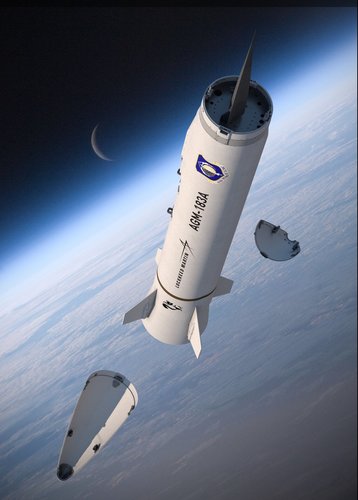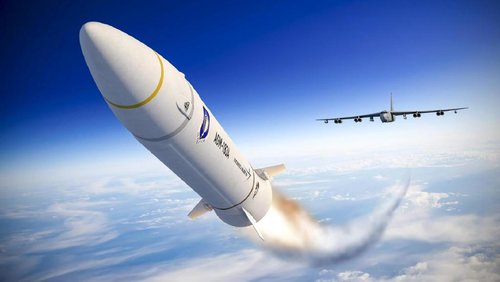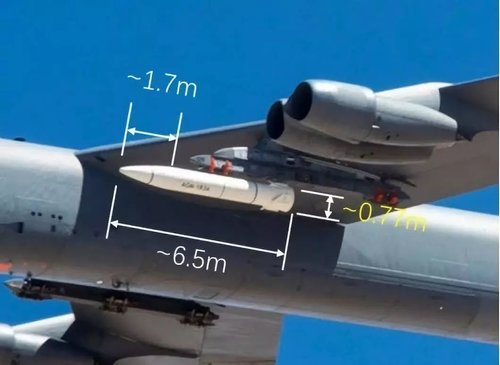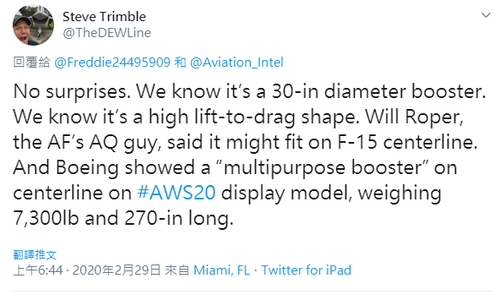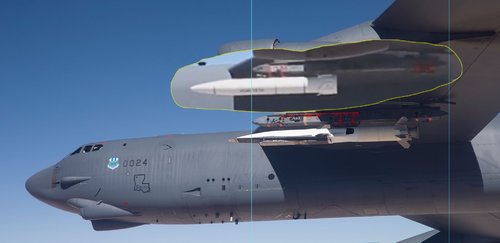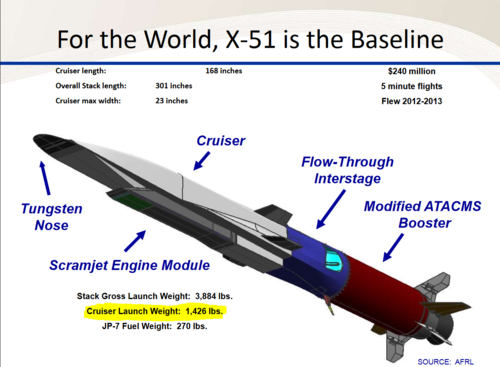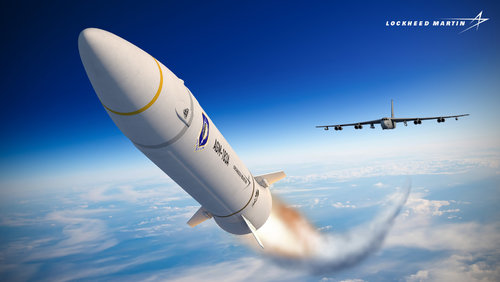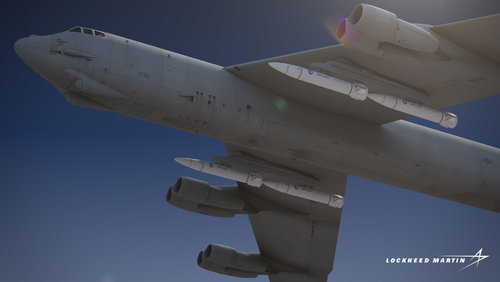You are using an out of date browser. It may not display this or other websites correctly.
You should upgrade or use an alternative browser.
You should upgrade or use an alternative browser.
Lockheed Martin AGM-183 Air-Launched Rapid Response Weapon (ARRW)
- Thread starter Moose
- Start date
- Joined
- 16 April 2008
- Messages
- 9,586
- Reaction score
- 14,417
So is this basically Air launched ballistic missile rather than a exotic air breathing hypersonic missile?
No, because it's a boost-glide weapon. That means that it's flying aerodynamically, not falling ballistically like a ballistic missile. But yes, the propulsion is all rocket, not air-breathing. Which is why this is closer to operational than the various air-breathing concepts.
- Joined
- 3 June 2011
- Messages
- 18,305
- Reaction score
- 12,130
By comparing it to the length of the X-51 stack (which is known, at 25') I get a dia of 26.5" (0.67m) x 19'4" (5.9m)
That weapon suspiciously looks like the upper two stages of a Minuteman III with a truncated payload shroud. Using dimensions someone posted above, 6.5 - 1.7 = 4.8 meters. Minuteman III 2nd stage: ~2.67 meters. Minuteman III 3rd stage: ~1.68 meters. So total 4.35m, plus presumably some interstage length, which puts it in the ballpark of 4.8 meters. If we were comfortable with a width of 1.3 meters, is this thing most of the top half of a minuteman III minus the 4th stage rocket/interstage and warhead bus?
Whatever it is, I feel it had to be a pre-existing booster of some kind for it to be rolled out as quickly as it was. If not MMIII, then some other small sized solid launcher from Orbital or whoever.
Edit: After reading through the general hypersonic topic, there are multiple projects that seem to involve a 34.5" wide missile that seems to have been adopted widely across all the various boost/glide projects, including the USN and Army. So that would fit much better in the diameters estimates posted here. I still suspect this booster had some kind of pre-existing pedigree, maybe an upper stage of a small to medium sized orbital system.
Whatever it is, I feel it had to be a pre-existing booster of some kind for it to be rolled out as quickly as it was. If not MMIII, then some other small sized solid launcher from Orbital or whoever.
Edit: After reading through the general hypersonic topic, there are multiple projects that seem to involve a 34.5" wide missile that seems to have been adopted widely across all the various boost/glide projects, including the USN and Army. So that would fit much better in the diameters estimates posted here. I still suspect this booster had some kind of pre-existing pedigree, maybe an upper stage of a small to medium sized orbital system.
Last edited:
Ravinoff
Hoodoo Operator
- Joined
- 5 October 2017
- Messages
- 130
- Reaction score
- 296
Edit: After reading through the general hypersonic topic, there are multiple projects that seem to involve a 34.5" wide missile that seems to have been adopted widely across all the various boost/glide projects, including the USN and Army. So that would fit much better in the diameters estimates posted here. I still suspect this booster had some kind of pre-existing pedigree, maybe an upper stage of a small to medium sized orbital system.
Digging around a bit, might have a few candidates.
- Orbital ATK Orion 38, used on Pegasus, Minotaur upper stages and Antares, 38"/94cm diameter
- Northrop Grumman Graphite-Epoxy Motor, specifically the 40" diameter GEM-40 from the Delta II
- Thiokol Star 37, upper stage on some Delta-family and Thor-Burner launch vehicles, 37" diameter
- Thiokol Castor 4 series, ~1m/36" diameter
Edit to add: 34.5" also compares very closely with Nike Zeus at 36" and the old WS-199C High Virgo and WS-199D Alpha Draco at 31", the latter two intriguingly were boost-glide test vehicles as well.
Last edited:
When I tried looking for candidates, I was bewildered with the variety of solid rockets from Northrop alone. They had a pdf that describes the GEM series for a dozen pages. So this is a hopeless task, and it might be that this particular booster is a black program come to light and the USN specifically contracted this size for submarine use*, since they appear to be spear heading the first wave of boost/glide for all services. The 2017 test was theirs; the army is adapting their full up round, and ARRW looks suspiciously like the same dimensions.
The only thing I could turn up was that the original army hypersonic boost glide from 2011 was STARS, which is a Polaris missile converted to a BM target. In that case converted to a glide vehicle booster. It’s if anything wider than minuteman upper stages and the weights of both would be prohibitive on a B-52 HSA beam adapter now that I think about it. So I definitely barked up the wrong tree.
The USN test in 2017 probably used something else, but they aren’t saying. But whatever they used, it looks like ARRW and LRHW share the same booster and biconical glide vehicle. Those programs seem to be the quick deployment low hanging fruit set for IOC in the 2023-2025 range, with more capability introduced in following programs.
*Edit to add: I've read a USN paper about hypersonics, and there position is they aren't tailoring it to any specific platform...but they want it to be flown from any platform, and submarines have the most stringent requirements. Ergo, they are making a sub launched weapon and worrying about what they put it on later. Spoiler alert, it will be a submarine - either a post refit SSGN or they will wait for Block V Virginia, which should come out around the same time. If they were being cheap they might keep the old Ohios as BGM-109 platforms but make sure all the payload extensions were Prompt Global Strik capable. They see to be the ones choosing the booster and the terminal shape right now. Which I personally am fine with, and I'm glad the services are standardizing to at least some degree. The wackier programs that involve smaller air breathing scramjets can wait until later, in my opinion. Something basic and boost glide that is just GPS and INS brings a lot to the table; terminal homing and air breathing can wait a few years.
The only thing I could turn up was that the original army hypersonic boost glide from 2011 was STARS, which is a Polaris missile converted to a BM target. In that case converted to a glide vehicle booster. It’s if anything wider than minuteman upper stages and the weights of both would be prohibitive on a B-52 HSA beam adapter now that I think about it. So I definitely barked up the wrong tree.
The USN test in 2017 probably used something else, but they aren’t saying. But whatever they used, it looks like ARRW and LRHW share the same booster and biconical glide vehicle. Those programs seem to be the quick deployment low hanging fruit set for IOC in the 2023-2025 range, with more capability introduced in following programs.
*Edit to add: I've read a USN paper about hypersonics, and there position is they aren't tailoring it to any specific platform...but they want it to be flown from any platform, and submarines have the most stringent requirements. Ergo, they are making a sub launched weapon and worrying about what they put it on later. Spoiler alert, it will be a submarine - either a post refit SSGN or they will wait for Block V Virginia, which should come out around the same time. If they were being cheap they might keep the old Ohios as BGM-109 platforms but make sure all the payload extensions were Prompt Global Strik capable. They see to be the ones choosing the booster and the terminal shape right now. Which I personally am fine with, and I'm glad the services are standardizing to at least some degree. The wackier programs that involve smaller air breathing scramjets can wait until later, in my opinion. Something basic and boost glide that is just GPS and INS brings a lot to the table; terminal homing and air breathing can wait a few years.
Last edited:
Ravinoff
Hoodoo Operator
- Joined
- 5 October 2017
- Messages
- 130
- Reaction score
- 296
I've read a USN paper about hypersonics, and there position is they aren't tailoring it to any specific platform...but they want it to be flown from any platform, and submarines have the most stringent requirements. Ergo, they are making a sub launched weapon and worrying about what they put it on later. Spoiler alert, it will be a submarine - either a post refit SSGN or they will wait for Block V Virginia, which should come out around the same time. If they were being cheap they might keep the old Ohios as BGM-109 platforms but make sure all the payload extensions were Prompt Global Strik capable.
Hm...here's a thought: a UGM-133 Trident II is 6ft11in diameter, with a tube size of 88in, With a 34.5" footprint, you can pretty handily fit two of these new hypersonics in place of a Trident cell, and by extension also drop a pair of them in place of each seven-round Tomahawk VLS on the Virginia-class and SSGN Ohio refits.
Actually I was thinking you could probably fit 3-4 per tube. Seven feet diameter would allow four missiles to sit abreast in two axis, depending on the containerization and the degree of shock hardening. The 34.5" diameter seems to be USN driven, which makes me think that as much as they claim to be agnostic about launch platform, they envision this is a Trident tube module for the non SSBN force tubes from the get go. The size and weight of this weapon don't translate into any surface vessel well. More over, if the range is on the order of 1000-2000 miles, if it isn't under water, it might as well be the Army version and hop around Guam between the current airbase, the munitions dump, and what's left of the old airbase that hasn't been paved over for ELINT and Satellite tracking. Plenty of hard surfaces for a truck mounted system to drive through in that rat's maze, so long as it at least had low pressure tires.
- Joined
- 18 May 2019
- Messages
- 640
- Reaction score
- 1,672
What do you think its ARRW?
“The purpose of the demonstration was to show that we’re still able to move the bulkhead from the forward intermediate bay to the forward location; increasing the intermediate bay capacity from 180 inches to 269 inches, said Lt. Col. Dominic Ross, B-1B program element monitor, AFGSC. “Additionally, we demonstrated that we can still carry weapons externally on six of the eight hard points, which increases our overall carriage capacity.”
“It increases the magazine capacity of the B-1B. Currently we can carry 24 weapons internally, now it can be increased to potentially 40 based on what type of pylon we would create,” Ross said. “This gets the B-1 into the larger weapons, the 5,000 pounders. It gets it into the hypersonics game as well.”
Ross said that the B-1B was designed with eight hard points to carry weapons, as well as a moveable bulkhead...

Air Force Touts B-1B Bomber's Potential To Carry Huge Hypersonic Missiles And External Stores
The B-1B may have to fight for its life in the not so distant future, but new upgrades could give it the ammo it needs to survive the budget ax.
Last edited:
- Joined
- 4 July 2010
- Messages
- 2,512
- Reaction score
- 3,084
The Navy program envisions 3 per SSGN/SSN Payload Tube, according to most of the chatter I've seen.I've read a USN paper about hypersonics, and there position is they aren't tailoring it to any specific platform...but they want it to be flown from any platform, and submarines have the most stringent requirements. Ergo, they are making a sub launched weapon and worrying about what they put it on later. Spoiler alert, it will be a submarine - either a post refit SSGN or they will wait for Block V Virginia, which should come out around the same time. If they were being cheap they might keep the old Ohios as BGM-109 platforms but make sure all the payload extensions were Prompt Global Strik capable.
Hm...here's a thought: a UGM-133 Trident II is 6ft11in diameter, with a tube size of 88in, With a 34.5" footprint, you can pretty handily fit two of these new hypersonics in place of a Trident cell, and by extension also drop a pair of them in place of each seven-round Tomahawk VLS on the Virginia-class and SSGN Ohio refits.
- Joined
- 1 April 2006
- Messages
- 11,364
- Reaction score
- 10,150
What do you think its ARRW?
Expanded carriage demonstration showcases possible B-1B capability
The 412th Test Wing, along with Air Force Global Strike Command and industry partners, held an expanded carriage demonstration with the B-1B Lancer bomber at Edwards Air Force Base, California, Aug.
www.edwards.af.mil
The demonstration showed a notional hypersonic missile mock-up attached to a Conventional Rotary Launcher; the same CRL used on the B-52H.
TAOG
I really should change my personal text
- Joined
- 7 October 2018
- Messages
- 108
- Reaction score
- 237
Lockheed Martin’s hypersonic ARRW set to pass critical design review
" ... Learnings from the TBG programme are to be eventually incorporated into ARRW, says Varly. He declines to discuss specifics of the effort.
“The sensitivities on the TBG programme are higher than others and we’ve got to be cautious,” adds Joe Monaghen, communications manager with Missiles and Fire Control. ..."

 www.flightglobal.com
www.flightglobal.com
" ... Learnings from the TBG programme are to be eventually incorporated into ARRW, says Varly. He declines to discuss specifics of the effort.
“The sensitivities on the TBG programme are higher than others and we’ve got to be cautious,” adds Joe Monaghen, communications manager with Missiles and Fire Control. ..."

Lockheed Martin’s hypersonic ARRW passes critical design review
ARRW is to officially pass the milestone on 27 February and the US Air Force is pleased with the missile's development progress, says Lockheed Martin.
- Joined
- 21 January 2015
- Messages
- 12,096
- Reaction score
- 16,233

Lockheed Martin’s hypersonic ARRW passes critical design review
ARRW is to officially pass the milestone on 27 February and the US Air Force is pleased with the missile's development progress, says Lockheed Martin.
TAOG
I really should change my personal text
- Joined
- 7 October 2018
- Messages
- 108
- Reaction score
- 237
Will Roper says:
1. ARRW is much smaller than HCSW, and it carry twice as many (than HCSW) on the B-52.
2.HCSW will still complete the CDR which allows a quickly restart in the future if needed.
3. If ARRW program doesn't experience mass growth, its in class to be able to fit on the center line of F15.

 www.flightglobal.com
www.flightglobal.com
Also, the F-15 EX has been reported that has the ability to carry a 7000 - 8000 lb hypersonic weapon.
HAWC is less than 5000 lb, and HCSW is too large that can not be carried by F 15.
" ... Lastly, the F-15EX is seen as a reliable launch pad for new, larger weapons, in particular hypersonic missiles that will not fit inside the F-35A's internal weapons bay, the source notes.
"We've got to carry a [7,000lb] to 8,000lb weapon that is enormous and doesn't fit in an internal bay," says the source. "And we need a very reliable platform that we well understand, that has power, space and cooling, and we can adapt quickly over the next 10, 12 or 15 years." ..."

 www.flightglobal.com
www.flightglobal.com
1. ARRW is much smaller than HCSW, and it carry twice as many (than HCSW) on the B-52.
2.HCSW will still complete the CDR which allows a quickly restart in the future if needed.
3. If ARRW program doesn't experience mass growth, its in class to be able to fit on the center line of F15.

Why the US Air Force chose hypersonic ARRW over HCSW
The US Air Force's decision to cancel the Hypersonic Conventional Strike Weapon (HCSW) and proceed with Air-Launched Rapid Response Weapon (ARRW) came down to size and shape of the missile, in addition to budgetary pressures and a desire to move toward production faster.
Also, the F-15 EX has been reported that has the ability to carry a 7000 - 8000 lb hypersonic weapon.
HAWC is less than 5000 lb, and HCSW is too large that can not be carried by F 15.
" ... Lastly, the F-15EX is seen as a reliable launch pad for new, larger weapons, in particular hypersonic missiles that will not fit inside the F-35A's internal weapons bay, the source notes.
"We've got to carry a [7,000lb] to 8,000lb weapon that is enormous and doesn't fit in an internal bay," says the source. "And we need a very reliable platform that we well understand, that has power, space and cooling, and we can adapt quickly over the next 10, 12 or 15 years." ..."

US Air Force sees F-15EX as cheap and quick fix
The US Air Force (USAF) is requesting funds from Congress for eight Boeing F-15EX fighters instead of more of its favoured aircraft, the Lockheed Martin F-35A Lightning II stealth fighter, in a move aimed at cutting costs.
- Joined
- 11 February 2007
- Messages
- 2,539
- Reaction score
- 4,298
Hmm, hadn't really appreciated what the internal carriage did for the size of the boost-glide vehicle. If ARRW is 30" diameter, then that image suggests the second stage wingspan could be as small as 24", with overall vehicle length somewhere in the 6' to 8' range.
- Joined
- 18 May 2019
- Messages
- 640
- Reaction score
- 1,672
- Joined
- 21 April 2009
- Messages
- 13,732
- Reaction score
- 7,617

Roper: The ARRW Hypersonic Missile Better Option for USAF | Air & Space Forces Magazine
USAF picked the Air-launched Rapid Response Weapon hypersonic missile over the Hypersonic Conventional Strike Weapon because it's smaller and more advanced.
- Joined
- 9 October 2009
- Messages
- 21,928
- Reaction score
- 13,552
A slightly different take here:

 www.flightglobal.com
www.flightglobal.com

Why the US Air Force chose hypersonic ARRW over HCSW
The US Air Force's decision to cancel the Hypersonic Conventional Strike Weapon (HCSW) and proceed with Air-Launched Rapid Response Weapon (ARRW) came down to size and shape of the missile, in addition to budgetary pressures and a desire to move toward production faster.
- Joined
- 18 May 2019
- Messages
- 640
- Reaction score
- 1,672

Global Strike Command is planning to put the hypersonic AGM-183 Air-launched Rapid Response Weapon externally on the B-1 bomber, and AFGSC chief Gen. Timothy Ray said he sees a conventional version of the Long-Range Stand-Off weapon as a sensible approach to replacing the conventional Air-Launched Cruise Missile if a weapon with longer range than the JASSM-ER is required.
Ray, in an interview that will appear in the May issue of Air Force Magazine, said he wants to refurbish and modernize the remaining B-1B aircraft after the Air Force retires 17 airframes from the fleet. That modification would include opening up eight external hardpoints on the bomber’s fuselage that were originally planned to carry two ALCMS each; subsequent treaty agreements took the B-1 out of the nuclear mission and the hardpoints were covered over.
“My goal would be to bring on at least a squadron’s worth of airplanes modified with external pylons on the B-1, to carry the ARRW hypersonic cruise missile,” Ray said. A B-1 squadron typically has 18 aircraft.
The 412th test wing at Edwards AFB, Calif., demonstrated additional B-1 carriage options last August, including the use of external hardpoints, as well as expanded internal bays and use of the Common Strategic Rotary Launcher with the stealthy, conventional JASSM-ER.
Some airplanes “will need significant structural work,” Ray said. “We can do smart things, and we’ve got support from Congress to do this. This is a thing that we’re working to get ourselves through. We’ve had a very good dialog.”
Modifying the B-1s to carry the ARRW was not an item requested in the fiscal 2021 budget, Ray said, but it’s “a project we’re working on. There are several versions that we could contemplate, but we believe the easiest, fastest, and probably most effective in the short term will be to go with the external pylons.” The ARRW, he said, is “a good weapon airframe and configuration match to get us quickly into that game.”
Asked if AFGSC’s preference is for ARRW versus other hypersonic missiles, Ray said, “I think we’re going to commit to the ARRW, because I think our carriage capability is good for that.”
The Air Force is also working on the Hypersonic Air-breathing weapon Concept, or HAWC, with the Defense Advanced Research Projects Agency. Pentagon officials said the Air Force has been thinking about mixed carriage of hypersonic missiles both internally and externally, on the B-1 and B-52. Using the external hardpoints and the CSRL, a B-1 could conceivably carry 31 hypersonic missiles.
Ray said the B-52 fleet also will be configured for hypersonic missiles, and because that airframe will have new engines, radar, communications, and weapons, the plan now is to increase the bomber test fleet from two to eight aircraft at Edwards. The B-1 will be able to take some of the “load off the B-52” in hypersonic missile testing, he said. The test program, which was developed in coordination with Air Force Materiel Command, is “very aggressive” and will required USAF “to commit more aircraft, and maintainers, and operators” to test over the next three-to-five years, Ray said.
“The bomber world has been very good about combining and integrating operational and developmental test and leveraging the number of resources. And this was a conversation with [AFMC] … that we came to this solution set.”
Ray said AFGSC has not set a requirement for a conventional version of LRSO to mirror the ALCM/Conventional ALCM USAF has operated for the last 30 years, but that such a weapon would be a logical approach if a weapon with longer range is needed.
“First things first: the ALCM is aging out on us,” and must be replaced, he said. But, “I’ve shot CALCM in anger…the utility of those is unquestionable.” He’s pleased with how LRSO is progressing—“I think that’s going to be a very, very good missile”—and if there was a sudden requirement for “an even longer-ranged cruise missile with conventional capability,” LRSO would be the place to start. However, Ray noted that changes to the program have to happen “within a treaty context.”
“Right now, we’re not asking for that, based on the prioritization of the nuclear piece, … but there’s things that could change in the future.”

AFGSC Eyes Hypersonic Weapons for B-1, Conventional LRSO | Air & Space Forces Magazine
Air Force Global Strike Command is planning to put the hypersonic AGM-183 Air-launched Rapid Response Weapon externally on the B-1 bomber.
Last edited:
Looking at the artwork showing the AGM-183A with the payload shroud jettisoned it appears that the boost guide vehicle in my opinion is too small. If as others have determined in this thread the diameter of the booster is about 30 inches the depth of the vehicle would be 1/5 to 1/4 of this measurement or 6 to 7 1/2 inches. It's width about 15 inches and length no more than 60 inches. How would you get the control surface actuators, power sources, a flight control computer, basic structure, and thermal protection system in this small volume?
bring_it_on
I really should change my personal text
- Joined
- 4 July 2013
- Messages
- 3,638
- Reaction score
- 3,753
Looking at the artwork showing the AGM-183A with the payload shroud jettisoned it appears that the boost guide vehicle in my opinion is too small. If as others have determined in this thread the diameter of the booster is about 30 inches the depth of the vehicle would be 1/5 to 1/4 of this measurement or 6 to 7 1/2 inches. It's width about 15 inches and length no more than 60 inches. How would you get the control surface actuators, power sources, a flight control computer, basic structure, and thermal protection system in this small volume?
The whole point of scrubbing the contractor released graphic would be to prevent this exact analysis IMHO.
bring_it_on
I really should change my personal text
- Joined
- 4 July 2013
- Messages
- 3,638
- Reaction score
- 3,753
Given that size, would internal carriage require a dedicated rack system? Any chance a rotary launcher could support a reduced number? Say, four more?
Probably could but then how many of these do you really want one bomber to carry? I guess that would depend upon the ultimate inventory but I really don't see them needing more than 4 or 6 in the short-medium term.
bring_it_on
I really should change my personal text
- Joined
- 4 July 2013
- Messages
- 3,638
- Reaction score
- 3,753

Agm-183a arrw missile model - TurboSquid 1418032
Royalty free 3D model AGM-183A ARRW Missile for download as 3ds, max, obj, fbx, and blend on TurboSquid: 3D models for games, architecture, videos. (1418032)
If the AGM-183A is similar in size to the AGM-129 (ACM) which had a 29 inch diameter then it won't fit on the rotary launcher in the B-52's bomb bay. The ACM was noted as an external weapon only on that aircraft. The B-1B on the other hand had the ability to carry 4 ACM's internally and 14 (2 single pylons and 6 dual carriage one) externally. They never developed the 2 single external pylons due to treaty limitations. Assuming 6 single carry pylons and the internal 4 gives you at most 10 on the B-1B. A as noted above 4 - 6 makes sense for a load-out.
Gen. Ray of GSC mentioned in his interview with Dave Deptula that they would move the AGM-183A to the B-1B from the B-52. Got to be a reason but I have no clue.
Gen. Ray of GSC mentioned in his interview with Dave Deptula that they would move the AGM-183A to the B-1B from the B-52. Got to be a reason but I have no clue.
- Joined
- 4 July 2010
- Messages
- 2,512
- Reaction score
- 3,084
The Drive on the state of ARRW.
The U.S. Air Force plans to buy at least eight prototype AGM-183A Air-launched Rapid Response Weapons, or ARRWs. This initial batch of these hypersonic missiles will support live-fire flight testing, set to begin in 2021, and could help give the service an early operational capability to employ the weapons a year later. However, there are risks of delays as the project is already a year behind schedule and has seen its total cost increase by almost 40 percent.
bring_it_on
I really should change my personal text
- Joined
- 4 July 2013
- Messages
- 3,638
- Reaction score
- 3,753
They have insight into the program and we don't. They also have a stipulated budget the DOD has offered to them and must invest appropriately to get to a desired capability end state by a particular time. The FY21 budget is nearly flat. This has pushed them towards prioritization. Congress could always step in and restore the funding if it does not buy the AF's argument given they too would have access to a similar level of data/reports. With FY22 budget prospects not looking that great (flat or lower most likely) funding one through completion is probably a more wise strategy anyway. Even with more risk, the TBG based ARRW is probably a more useful weapon for the Air Force.
It is undoubtedly the more advanced design with greater capability. Just hoping the flight testing goes well. Worst case, presumably HCSW could be dusted off next year if major problems arise. The glider is supposed to be from DARPA TBG - has that ever been flight tested?
E-V Bomber
ACCESS: Restricted
- Joined
- 22 October 2019
- Messages
- 20
- Reaction score
- 24
It is undoubtedly the more advanced design with greater capability. Just hoping the flight testing goes well. Worst case, presumably HCSW could be dusted off next year if major problems arise. The glider is supposed to be from DARPA TBG - has that ever been flight tested?
No, TBG hasn’t been flight tested yet, which is likely the main cause of delays for ARRW. Ironically DARPA who are famous for agile development are the main factor holding up the ARRW/TBG program...
- Joined
- 4 July 2010
- Messages
- 2,512
- Reaction score
- 3,084
They can't afford to keep HCSW going on the chance ARRW fails, unless they want to delay ARRW further. Reminder that the gliding body HCSW would have used is still under development with the Navy and Army, so the opportunity exists for the Air Force to return to it later.I'm a little disturbed that they are wrapping up HCSW this summer without test firing AGM-183 even once.
Similar threads
-
-
Hypersonic Conventional Strike Weapon (HCSW)
- Started by bring_it_on
- Replies: 30
-
-
-

